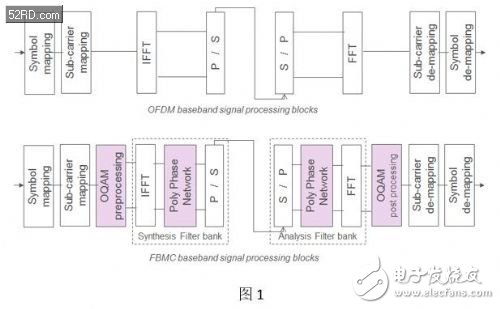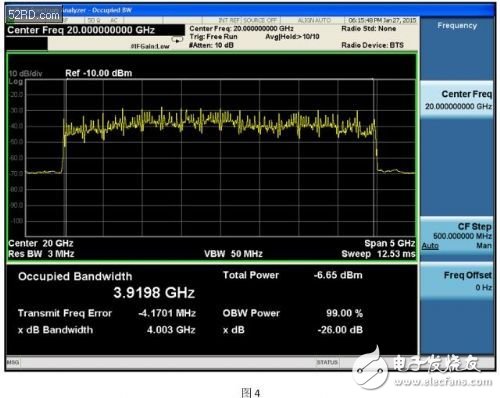The core technology for the fifth-generation mobile communication system to achieve ultra-high data transmission targets is the millimeter-wave band and ultra-wideband signal modulation up to 500MHz-4GHz, far exceeding the frequency range and modulation bandwidth used by the latest 4G and WLAN technologies. It poses a great challenge to the current 5G research and product development. It needs to develop new devices, modules, basebands, and RF microwave systems. However, the current standards and verification and test methods for wireless communication technologies are all RF below 6 GHz. The frequency band and the modulation bandwidth within 160MHz lack the mature and effective millimeter wave and ultra-wideband signal generation and signal analysis methods with first-class performance indicators. This paper introduces the verification test platform specially designed for 5G advanced technology research and development, based on Keysight SystemVue system design simulation software, M8190A ultra-wideband arbitrary wave generator, E8267D microblog vector signal generator, N9040B UXA broadband vector signal analyzer or The 63G real-time oscilloscope can directly generate and analyze 5G physical layer signals up to 4GHz bandwidth, such as FBMC. The system provides a gradual and fast UWB hardware linear distortion correction method that enables the measurement system to achieve the industry's best vector error characteristics. The system can be used to assist in the development and verification of 5G physical layer algorithms, the design and debug of millimeter-wave and ultra-wideband devices and modules, 5G channel modeling and verification, initial transmitter and receiver testing, and defense and aerospace Ultra-wideband signal generation and analysis in aerospace, electronic warfare, radar, etc., with good flexibility and scalability.
1. Introduction: The challenges of technical research and test verification currently facing 5G
The evolution of wireless communication has gone through 4 generations. The earliest appeared is analog communication, which can only transmit voice services. 2G is mainly GSM, mainly transmitting voice and low-speed data services, and 3G includes WCDMA and TD-S, etc. Mobile Internet operation has promoted the popularity of smart phones. 4G LTE realizes high-speed wireless access and rich multimedia applications, while 5G will bring a revolutionary leap to wireless communication. The core goal of 5G is to achieve ultra-high-speed data transmission. The transmission rate reaches several G or even 10G bit rate, thus completely solving the current network communication rate bottleneck. In order to achieve the goal of ultra-high-speed data transmission, 5G needs to adopt a new wireless transmission technology. Due to frequency resources and bandwidth problems, it is necessary to use a higher frequency band, such as millimeter wave, and the modulation bandwidth will span from the current tens of M to 500 M. 3GHz, and will also use new physical layer technologies including modulation coding and multiple access, so the research and verification of 5G key technologies is the main task at present.
At present, the research and test verification for 5G mainly faces three major challenges. The first is how to generate and analyze 5G format signals quickly and easily in software. The second is whether hardware can realize the transmission of 500 M to 3 GHz UWB signals in the millimeter wave band. And receiving, the third is the need for comprehensive verification and testing capabilities, such as system-level verification and software hardware and even module verification and testing.
2, 5G millimeter wave and ultra-wideband signal verification test platform
In order to cope with the challenges brought by 5G and help customers quickly enter 5G advanced technology research and development, Keysight has built a 5G verification test platform based on Keysight SystemVue system design software, M8190A ultra-wideband arbitrary waveform generator, E8267D microwave Vector signal generator, N9040B UXA ultra-wideband signal analyzer and 90000 series high-bandwidth oscilloscope, can directly generate and analyze 5G physical layer signals in the millimeter wave band over 500M bandwidth, such as FBMC, for system level and hardware and software module verification and test. The platform provides a simple and fast UWB hardware linear distortion correction method, which enables the test system to achieve the best 5G transmit signal quality in the industry. The platform can be used to assist in the development and verification of 5G physical layer algorithms, design and debug of millimeter-wave and ultra-wideband devices and modules, 5G channel modeling and verification, initial transmitter and receiver testing and verification, and is widely used. Good flexibility and scalability.
2.1 SystemVue-based 5G FBMC reference library
The SystemVue-based W1906BEL 5G baseband library provides ready-to-use reference signal processing user patented design for 5G technology research. With this baseband library, baseband physical layer designers can save time and improve productivity. System architects and algorithm development Staff and baseband hardware designers can take advantage of the integrated simulation environment, apply dynamic link-level scenarios, implement and validate communication physical layer signal processing designs, and easily redesign reference transmitters and receivers for optimal performance. And compare it with other candidate technology designs. The W1906BEL 5G baseband library includes source code, models, subsystems, simulation examples and basic components. It can provide digital signal processing modules for 5G candidate waveform technology FBMC, end-to-end physical layer transmit and receive simulation models, frequency and time synchronization. Channel estimation and correction, generating reference waveforms to verify RF circuit design, system-level performance verification and BER/FER testing, and the ability to connect physical technology instruments to build physical simulation and test platforms.

Figure 1 shows the difference in implementation between FBMC and OFDM. FBMC mainly includes symbol mapping, subcarrier mapping, OQAM processing, IFFT, filter bank processing, and serial conversion. The main difference between FBMC and OFDM is OQAM and filter bank processing.
The process of converting the QAM signal into Offset QAM mainly consists of two steps. First, the QAM symbol is converted from the complex number to the real and imaginary real numbers, and the sampling rate is doubled, and then multiplied by the sequence, m represents Sub. -channel,n represents a discrete time variable, OQAM processing is to make the real or imaginary part of the QAM symbol a time offset of 1/2 symbol period, for continuous Sub-channel, assume m (even number) and m+1 (odd number), for Sub-channel m, the real part of the QAM symbol is time-shifted by 1/2 symbol period, and the sub-channel m+1, the imaginary part of the QAM symbol is time-shifted by 1/2 symbol period. . The main benefit of OQAM processing is the ability to reduce the peak-to-average ratio of the signal to PAR.

The above formula outputs the S[m] expression for the filter bank, which also contains the OQAM processed part.

The meaning of the filter bank means that the first filter is a prototype filter, and the other filters are obtained by frequency shifting the prototype filter. The characteristics of the prototype filter are determined by the aliasing coefficient K. The aliasing coefficient K can be expressed as the ratio of the impulse response time of the filter to the period T of the subcarrier symbol, and is also the number of subcarrier symbols aliased in the time domain. It can be seen in 2 that the larger the K value, the steeper the roll-off of the filter, but the larger the number of sidelobes of the aliasing subcarriers, so there is interference between the FBMC subcarriers, which is not orthogonal, and OFDM can be regarded as K=1
Preamble and Pilot signals are also inserted in the FBMC transmitter model. Time and frequency synchronization, channel estimation and equalization correction, Pilot phase tracking correction, etc. are provided in the receiver model based on Preamble and Pilot, so that hardware and hardware can be implemented. Instrument connection to build the actual transmitter and receiver
2.2 Verify the structure and composition of the test platform
The 5G verification test platform shown in Figure 3 combines 5G FBMC software processing with millimeter-wave and ultra-wideband hardware transmit and receive capabilities to provide the industry with the ability to fully verify 5G system-level performance while also being able to R&D of 5G software or hardware combined with the platform, or replacing modules in the platform for verification and testing

SystemVue and the previously described W1906BEL library form part of the software processing. The hardware platform is divided into signal generation (transmitter) and signal reception analysis (receiver).
The transmitter hardware consists of the M8190A wideband arbitrary waveform generator and the E8267D PSG microwave vector signal source. M8190A is a modular instrument based on AXIe architecture. Each M8190A can provide two channels of differential signal output. Each channel has 8GHz sampling rate 14bit quantization or 12GHz sampling rate 12bit quantization, 5GHz analog bandwidth, sampling rate can be flexibly adjusted, and built-in Digital up-conversion DUC function. In order to realize the millimeter wave band signal generation, a two-channel IQ output mode is adopted. The two IQ differential signals from the M8190A are sent to the E8267D PSG and modulated to the carrier frequency of the microwave/millimeter wave. The E8267D PSG has a frequency range from 250KHz up to 44GHz. It not only has a built-in baseband signal generator, but also a wideband IQ signal modulator. The nominal wideband IQ modulation bandwidth is 2GHz. The actual test shows that the IQ modulation bandwidth of the E8267D PSG output is actually Exceeding 2GHz, the combination of M8190A and E8267D PSG is the only 5G millimeter wave and ultra-wideband signal transmission platform in the industry that can fully meet the key technical requirements of 5G.
The receiver hardware can choose N9040B UXA or 90000 series high-bandwidth oscilloscopes. The N9040B UXA is the latest signal analyzer covering the frequency range of 3Hz to 26.5GHz. The IQ demodulation analysis bandwidth and real-time spectrum measurement bandwidth are the highest in the industry. 510MHz, with 14bit quantization in full bandwidth, no distortion dynamic range in IQ bandwidth over 75dBc, phase noise index also reached the industry's highest -136dBm/Hz (1GHz carrier, 20KHz offset), taking into account 5G wideband signal receiving measurement and RF The best choice for the dynamic range of microwave measurement accuracy, the 90000 Series high-bandwidth oscilloscopes can provide up to 63 GHz of receive and analysis bandwidth for higher bandwidth requirements.
If you are new to the concept of using an electric kettle, you might be overwhelmed by the variety of electric kettles that are displayed on the store shelves and have difficulty deciding which one would be the best to suit your individual needs or desires. This introduction will give you some basic information about some of the features that are available on various types of electric kettles so that you can make a more informed decision when choosing one for use in your home.
Features:
Spend few minutes to boil : After 5 minutes, hot water will finish for you to drink.
3 protection functions : The on/off button is on the handle, making it easy to turn the kettle off when you pick it up. A concealed heating unit reduces the amount of buildup in the kettle.
It will be a problem when you forget to close the button.Once the water boils the kettle shuts itself off.Do not have to worry about damaging it by letting it run dry. When water runs dry,It will cut the electric by itself.
Multiple Cups: Water can be loaded to 1.8Liter.
Materials :
Food grade stainless steel, more healthy and hygienic. PP handle wieh heat insulation material provides scald resistance. Durable controller performance with 360 degree rotation cordless base design.
OEM & ODM service : Try best to support you during production and provide better after-sales service.Enhance your brand popularity.
Application:
Make a cup of tea.
Boil eggs.
Cook noodles.
Electric Water Kettle
Electric Water Kettle,Aluminium Electric Water Kettle,Mini Electric Water Kettle,Stainless Steel Electric Water Kettle
Guangzhou Taipeng Electrical Appliances Technology CO., LTD. , https://www.kettles.pl